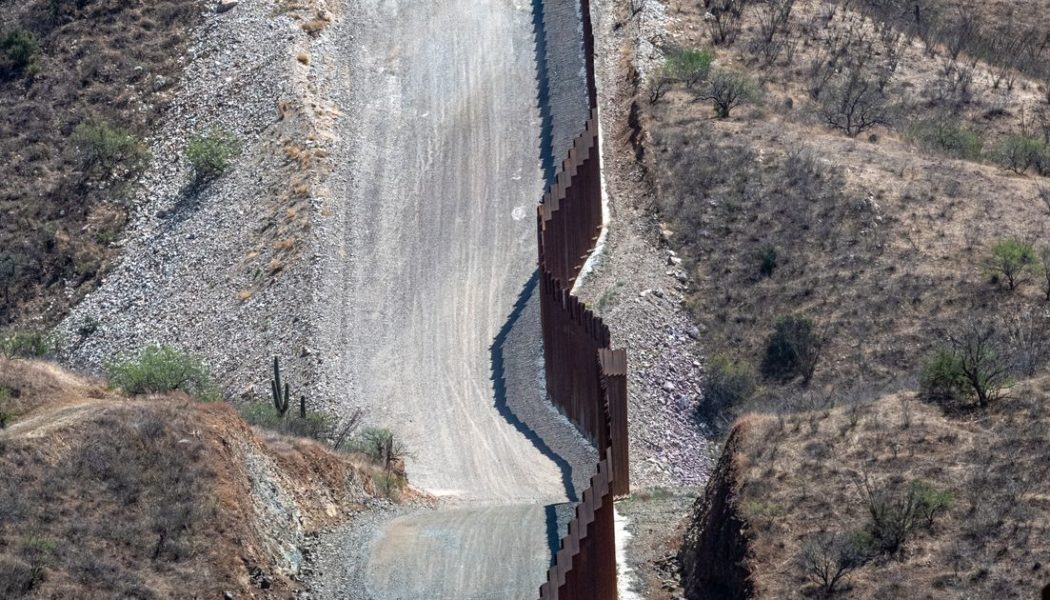
For more than two years, Title 42 has created a two-tiered migration system along the border. Some migrants try their hand at crossing, hiring a smuggler to guide them through — or, increasingly, to tell them how to get across — the rugged terrain of the Sonoran Desert. If they’re caught by Border Patrol and expelled to Mexico, they might try again. So far, during the 2022 fiscal year, which began last October, CBP reported 195,112 encounters in the Tucson sector, 79 percent of which resulted in expulsions. Other migrants have found themselves stranded in Mexico, either after being expelled or because they know there’s no way they’ll survive the journey across the border, where they wait for Title 42 to be lifted. The policy has turned Mexican border cities into waiting rooms for US-bound asylum seekers, some of whom have spent months living in shelters, rented apartments they share with other migrants, or on the streets, awaiting Title 42’s end.
I met Andrea at one such shelter in Sonoyta, Mexico, just across the border from Lukeville, Arizona. The smuggler she hired to get her and her three children across the border last November told her they’d only have to walk for 40 minutes. “It turned into hours — three, four hours walking with my children,” she said. Andrea carried her youngest, who was just four years old at the time. Her 12-year-old daughter and 10-year-old son walked alongside them. They brought a little bit of water but no food, supplies, or extra clothing. They were freezing. The smuggler had them cross around midnight, and desert winters are unexpectedly cold.
Border Patrol found Andrea and her children around 3AM and detained them until sunrise. By the next morning, Andrea and her children were back in Sonoyta.
It was Andrea’s second failed attempt across the border, and it cost her $6,000. She had fled Honduras two months earlier with her children after she was harassed by a prominent member of her community and threatened for speaking out against him. Andrea, a single mother, found herself in an impossible position: she could stay in Honduras, where she feared for her children’s safety, or she could leave the only home she had ever known. (Andrea asked to be referred to by a pseudonym to protect her from retaliation and to not jeopardize the asylum case she hopes to file if she’s allowed into the US.)
Before ending up in Sonoyta, Andrea and her children went to Matamoros, Mexico — across the border from Brownsville, Texas — where she found a smuggler who said he could get her and her children into the US. That attempt cost her $14,000. She told me she borrowed the money from someone in Honduras and promised to pay them back as soon as she found work. After walking for a couple of hours, Andrea used her cell phone to call Border Patrol, assuming they would help her once she explained that she was seeking asylum.
The Sonoran Desert isn’t an untouched wilderness. It’s a massive unmarked grave.
Andrea and her children spent the next week in a Border Patrol facility in Texas. She hardly slept for seven days — the rooms were cold, the blankets they had been given were made of thin, crinkly mylar, and her two oldest children had been taken to different cells. Every time Andrea tried to tell an agent she was seeking asylum, she was ignored. And then, one day, without any warning, she and her children were put on a bus and driven to an airport. She saw signs saying they were in Houston but had no idea where they would end up. “We got on the plane without knowing where we were going,” she said. “They don’t tell you where they’re taking you — just, ‘Get on, go.’” A few hours later, they were in Arizona.
A Border Patrol bus drove Andrea, her children, and a group of other migrants from Phoenix to Nogales, where they were taken across the border to Mexico. Since March 2020, the federal government has used Title 42 to turn away most unauthorized immigrants who arrive at the border. These expulsions are intended to limit the “introduction or spread” of a communicable disease into the US, and in theory, they’re supposed to be done quickly. But since last January, the government of the Mexican state of Tamaulipas has forbidden expulsions of families with children aged seven or younger. Instead of allowing these families into the country to seek asylum, CBP has been “laterally” expelling them to other parts of the border. Put simply, when the agency can’t quickly expel migrants — which proponents of Title 42 say it needs to do for public health reasons — it detains them for prolonged periods of time, flies them across the country, and throws them out anyway. All told, Andrea and her children spent more than a week in Border Patrol custody and were expelled to a city more than a thousand miles away from where they had first crossed.
“They just leave you there, thrown on the street without any idea what to do and with no money in your pocket,” she said. Andrea and her children spent the night with a group of migrants in a rented motel room. The next morning, a few women told her they met someone who promised to get them across the border — for a price. She called the person in Honduras who had lent her the money and asked if she could borrow more; she was desperate.
The smuggler took the migrants to Caborca, two and a half hours southwest of Nogales. From there, they were taken to a beach town in western Sonora, then to an abandoned house in Sonoyta, right on the border with Arizona. Andrea said she and her children were kept in the house for about a week. When the smugglers finally let her go, they told her the journey across the desert would be quick.
It only took a few hours for Border Patrol to find Andrea. If they hadn’t found her, she and her children might have walked for days or even weeks. One of the concrete walls in the migrant shelter where Andrea stayed hung the Pina County Medical Examiner’s map, which shows how long and dangerous the journey actually is. It’s a two-day walk to Ajo and two and a half weeks to get to Phoenix. The map is covered in hundreds of red dots, each representing a person who died along the way. A caption on the map’s upper-left corner pleads: “Don’t go! There isn’t enough water! It’s not worth it!”
At least once a week, Bob Kee goes on a hike with the intention of saving lives. Carrying gallon jugs of water and plastic bags stuffed with calorie-dense snacks — peanuts, cans of Vienna sausages, small pouches of gummy candies — Kee and other members of the Tucson Samaritans hike the same trails migrants traverse on their journeys north. Sometimes, Kee will come across people in need of help: dehydrated migrants who have been in the sun for too long, weary travelers with blisters on their feet and little food on their bellies. Water is the scarcest and most precious resource in the desert. For migrants, it’s often the difference between life and death.
“To encounter someone is so serendipitous because you’ve got all this stuff for miles and miles, and then you happen to be at the same place at the same time as someone,” Kee told me on a humid mid-July day. We were on a trail outside Arivaca, a town of about 700 people located 60 miles south of Tucson and just north of the Mexican border. Kee gave me a walking stick and asked if I could carry a gallon of water in my other hand. It would be an easy hike, he said, just five miles round-trip. We ducked under branches and dropped rocks in the creek to cross without getting our shoes wet. Kee made small talk to keep my energy up, telling me about how he loves The Beatles, especially their 1969 album Abbey Road. At 72, he’s still an avid hiker, and it’s hard to keep up with him even though I can tell he’s going slow for my benefit. It rained earlier in the day, and the trail is slippery with mud.
Sometimes, Kee doesn’t see a soul on his hikes. Even then, the signs of clandestine passage through the desert were everywhere: discarded packets of electrolyte powder, hastily torn open bags of jerky, tubes of applesauce emptied of every drop. Migrants try their best to pass through the desert undetected, but they can’t help leaving things behind. And sometimes, Kee or one of the many other Arizonans who have dedicated their free time to keeping migrants alive will encounter someone long after it’s too late to help them.
We didn’t see anyone that day, but Kee told me about the people he’s encountered on other hikes. He interrupted himself often, pausing a story about a mother and daughter from Guerrero or a Salvadoran woman he used to visit in ICE detention to point out the hidden beauty of the desert: century-old saguaros with six arms, a single red flower blooming on the tip of an ocotillo plant. Once, he said, he came across a group of nine people who wanted to give up and turn themselves in to Border Patrol. “We waited for three and a half hours,” he said. In the meantime, they ran into a pair of birders who were looking for a small, puffy bird that only comes out at night. They stayed out until a quarter after eight — on a desert trail with no artificial light — waiting for Border Patrol, but the agents never came.
During my two days of meetings with Border Patrol, every agent and official I spoke with claimed they respond to every single emergency call they receive. “We don’t want anybody to die,” said Jesus Vasavilbaso, an agent who was raised on the other side of the border in Nogales, Sonora. Border Patrol has 34 rescue beacons installed in the western edge of the Sonoran Desert. Each beacon has a sign in three languages — English, Spanish, and Tohono O’odham — explaining its purpose. “If you need help, push the red button. Rescue personnel will arrive shortly to help you. Do not leave this area.”
Vasavilbaso said the beacons are used less frequently now that most migrants have cell phones. The agency advises migrants to call 911 — rather than relatives, friends, or advocacy groups — if they get lost in the desert, and Border Patrol often publishes press releases detailing its rescues of migrants in distress.
But a report from No More Deaths, another humanitarian aid group that leaves water in the desert, found that Border Patrol didn’t conduct search and rescue mobilizations in 63 percent of cases between 2015 and 2019. No More Deaths found “significant patterns of negligence” in 37 percent of the search and rescue missions that were conducted.
The government’s relationship with humanitarian aid groups like No More Deaths and the Samaritans is often antagonistic. There’s evidence that Border Patrol agents vandalize food, blankets, and water jugs that volunteers leave in the desert, sometimes slashing the jugs so the water pours out. Volunteers have been arrested for leaving water jugs in the desert. Four No More Deaths volunteers were charged with operating a motor vehicle in a wilderness area, entering a wildlife refuge without a permit, and abandonment of property for leaving water in the Cabeza Prieta National Wildlife Refuge. “All of this, in addition to violating the law, erodes the national decision to maintain the Refuge in its pristine nature,” the federal judge who convicted them wrote in his decision.
The desert — even in federally protected wildlife refuges like Cabeza Prieta and Organ Pipe — is far from pristine. There are hidden cameras and sensors everywhere. There’s detritus left behind by migrants passing through and tracks left by Border Patrol’s off-road vehicles. The signs of human movement through the desert are impossible to miss; so is the evidence of the government’s expensive, futile attempt to stop people from crossing.
The one thing that’s invisible to the untrained eye is the presence of the people making the journey. Those who make it go to great lengths to not be seen. Those who don’t — the ones who succumb to the elements despite their best efforts — often disappear into the landscape before they can be found. De León, the anthropologist, is the executive director of the Colibrí Center for Human Rights, an organization that helps locate migrants who have gone missing in the desert. In 2012, De León was part of a team of researchers who killed three pigs, dressed them in clothes similar to what migrants wear, and placed them in the desert. Their goal was to see how long it would take for the sun, sand, and scavenging animals to claim the pigs’ bodies. After a few days, turkey vultures feasted on their carcass. After five weeks, the researchers were only able to find 62 percent of one of the pigs’ skeletons. “With enough time,” De León wrote, “a person left to rot on the ground can disappear completely.” The Sonoran Desert isn’t an untouched wilderness. It’s a massive unmarked grave.
Fourteen years before Border Patrol first tested out its deterrence strategy, a group of war refugees from El Salvador set out across the Sonoran Desert hoping to find a safe haven in the United States. Dora Rodriguez, just 19 years old at the time, was among them. It was 1980, a year into El Salvador’s brutal civil war. Rodriguez and her fellow travelers fled their country hoping to make new lives — and, really, to avoid death — in the United States. Rodriguez and her cousin paid $1,300 each for the promise that it would be a quick, painless journey. That was a lie. They were part of a group of two dozen Salvadoran exiles, all middle-class people who could afford to pay the smuggler’s fee.
Some of the ladies wore high-heeled shoes; other members of the group carried rolling suitcases filled with nice clothing, toiletries, and cologne. Some of the women in the group would be reuniting with husbands who had made it to the United States and dressed up for the occasion. None of them were prepared for the harshness of the Sonoran Desert, for the way their feet would blister and swell after days of interminable walking. Nobody knew how hot it would get during the day — temperatures surpassed 110 degrees — or how frigid the nights could be. It felt like every single piece of the landscape — the punishing sun, the towering saguaro and organ pipe cacti, the spiky cholla shrubs, the coyotes, and turkey buzzards — had been designed to kill them.
“One of the compañeras had rollers in her hair so she would be ready,” Rodriguez told me, “and she died with her rollers in.”
They had no idea where they were. The desert can have that effect on people; all you see in any direction is the orange dirt and bright blue sky. Shrewd travelers know which landmarks to look out for or which mountain to keep to their right if they want to walk north, but no one in Rodriguez’s group had that information. Their guide had abandoned them. They were only given a gallon of water each. People started to get sick, delirious from the heat and dehydration. They started to unpack, spreading their clothing over the desert shrubs so they could lie in the shade. A few people went to look for help and never came back. Thirteen of the migrants succumbed to the elements, dying of exposure. According to media reports from the time, the survivors drank aftershave, liquid deodorant, and the juice of nearby cacti to stay alive.
“I never got asylum,” Rodriguez told me as we drove down to Sasabe, Sonora, where her organization Salvavision runs Casa de la Esperanza, a resource center for migrants.
She ended up marrying a US citizen, which gave her the ability to get a green card and, eventually, citizenship. Shortly after settling in the US, she got involved with the nascent Sanctuary Movement, a group of churches that tried to shield Central American asylum seekers from deportation. Over nearly four decades, she’s sponsored asylum seekers and let them stay in her home, gotten involved with the Samaritans, and participated in the occasional protest or water drop. But in 2015, after Trump announced his candidacy, Rodriguez became a full-time activist. “For six years now, it’s been nonstop,” she said. “They’re killing us.”
Rodriguez noticed the Border Patrol bus in her rearview mirror. From our vantage point, it was hard to tell how many migrants were in the vehicle, but Rodriguez had a good idea of what was happening. The migrants were being expelled back to Mexico, either to Nogales or Sasabe. Rodriguez always drives the speed limit or just under it, making her a rarity among Arizona drivers I encountered. The bus sped past us.
As we made our way toward the border, Rodriguez told me about the recent challenges Casa de la Esperanza had faced. The organization’s goal isn’t just to help migrants make it to the US but to give them the tools to stay home if they can. They have an embroidery program where women in Central America get paid to make blouses and other crafts that are then sold in Tucson — it works for people whose main concern is poverty. But higher wages can’t help people living amid cartel or gang violence.
Casa de la Esperanza had also tried setting up a service for migrants who wanted to turn back. They hired a local driver in Sasabe to take migrants back to Altar, a city about an hour and 45 minutes south of Sasabe that’s the first stop for migrants en route to the US via Arizona. Rodriguez said they had to stop after an armed man showed up at Casa de la Esperanza one day demanding to know where a certain migrant had gone. The service, called Regresa a Casa — Spanish for “Return Home” — is running again but only for migrants who never hired a smuggler. “There’s a lot of danger for us,” Rodriguez said. “We’re taking away their ‘merchandise,’ so to speak.”
There were only a handful of people at the resource center when we got there, none of whom were migrants. Two of the five women there were employees; the rest were Sasabe locals who were volunteering with the group. From the outset, Rodriguez wanted Casa de la Esperanza to be more than a place for migrants who were just passing through; she also wanted it to be a hub for members of the community, a place where women could stop by to chat or have a cup of coffee.
The daughter of one of the resource center workers told Rodriguez that a group of migrants had come by earlier in the day but left quickly. They had been expelled with their guide, and the smuggler had no interest in what Casa de la Esperanza was offering. While we talked, a new group of a dozen migrants arrived. They anxiously huddled in a semicircle in the building’s backyard, checking their phones to see if their smuggler had contacted them.
“The normal Fourth Amendment rights for search and seizure do not apply here.”
It was clear that the migrants had barely made it across the line before Border Patrol caught and expelled them. They seemed nervous but didn’t look tired; their clothes were clean, free of the dirt, sweat stains, and cactus burrs that would have accumulated if they’d made it onto the mountain trails. Their encounter with Border Patrol left them shaken up, but they hadn’t experienced the worst of the desert yet.
They stayed long enough for Rodriguez and the other volunteers to ask where they were from. In clipped accents betraying indigenous ancestry, one member of the group said they were from Chiapas, a state in southern Mexico bordering Guatemala. The volunteers gave each migrant a small nylon bag stuffed with winter clothes and a blanket. As soon as their smuggler called, they left. The scrambled eggs one of the volunteers had just finished cooking were fed to the shelter’s three-legged dog so they wouldn’t go to waste.
I have no idea what happened next. There were 13,084 Title 42 expulsions in the Tucson sector in December, the month I visited Casa de la Esperanza. The 12 migrants from Chiapas comprised just a tiny fraction of that number. Maybe they got a little further on their second try and ended up trekking through the mountains. Maybe they came across a few gallons of water left behind by someone from the Samaritans or No More Deaths, which gave them the strength to keep going for a few hours. Maybe one of them got injured, and another member of the group stayed behind while the others looked for help. Maybe they never came back. Maybe they tripped a sensor or were picked up on a game camera, and Border Patrol found them again. Maybe they were expelled into Mexico, but maybe they weren’t.
Just over 2,600 people Border Patrol encountered in the Tucson sector that month were paroled into the country; more than half of them were unaccompanied children. Among the single adults, there were 370 Mexican nationals. Maybe the 12 migrants who stopped by Casa de la Esperanza on that warm December afternoon were among them.
There are a few things I know for certain. Nearly every person I met in southern Arizona told me they keep a few gallon jugs of water in their car, just in case they happen to come across a migrant in distress on the side of the road. I started doing the same, but I never saw anyone; maybe I wasn’t looking hard enough. In the middle of my first trip to Arizona, I got pulled over by a Border Patrol agent on the road to Lukeville. I had six gallons of water in my trunk and, in the backseat, a pair of carpet shoes that Kee had found on a previous hike and given me to remember my trip. I hadn’t thought to hide the shoes or the water; I didn’t feel like I had anything to hide. But the longer the Border Patrol agent spoke to me, the more I worried about the items in my backseat and what they could signal. His aggressive line of questioning seemed designed to catch me in a lie. I felt at once defensive and scared, like any wrong answer would lead to him searching my car and arresting me.
As the desert has become more difficult to cross, the people who dedicate their free time to saving migrant lives have been increasingly surveilled and criminalized. Giving a thirsty person water isn’t illegal in and of itself, but the most mundane acts of kindness take on highly political meaning in the borderlands. As one Customs and Border Protection agent told me while giving me a tour of the Mariposa port of entry in Nogales, “the normal Fourth Amendment rights for search and seizure do not apply here.” The same technology used to track migrants through the desert is used to monitor the members of humanitarian aid groups, the comings and goings of anyone who drives north on a highway in Arizona, and of people protesting police violence in Minneapolis and Buffalo.
When I toured a Border Patrol office in November, a big TV in the corner was set to Fox News. An anchor talked about how the agency was hemorrhaging agents because of low morale. The Biden administration had ushered in all these changes, the segment claimed; Border Patrol agents felt like their job description changed overnight. Instead of apprehending migrants, they were being told to welcome them. But really, very little has actually changed.
Summer is here again; the rising temperatures will likely contribute to a rise in deaths. Earlier this summer, more than 60 migrants climbed into the back of a hot, un-air conditioned tractor trailer, only to be abandoned by their smuggler just outside San Antonio. Fifty-three of them died; the youngest was 13 years old.
Even now, nearly a year after my first visit, the dynamics I witnessed are still more or less the same. It’s hard to reckon with all this loss of life, with the knowledge that this happens by design, with the reality that this happens year after year with no end in sight.









